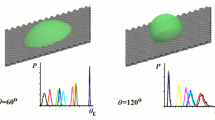Abstract
Surface microstructures of solid materials play a significant role in various wetting and dewetting phenomena. In the present paper, the effect of micro- and nano-structures of a substrate surface on the morphology and evolution of liquid droplets and thin films is examined. The governing equations satisfied by droplets and films on a sinusoidal surface are derived by considering van der Waals force, surface tension, gravity and hydrostatic pressure. The morphologies of both liquid droplets and thin films are numerically simulated under various characteristic sizes of roughness. It is found that the droplet shapes show a significant dependence upon the characteristic sizes of substrate microstructures. A thin liquid film on a hydrophilic substrate may have a horizontal surface or replicate the substrate morphology, depending on the wavelength of roughness.
Similar content being viewed by others
References
de Gennes P.G., Brochard-Wyart F., Quere D. (2003) Capillarity and Wetting Phenomena: Drops, Bubbles, Pearls, Waves. Springer, Berlin Heidelberg New York
de Gennes P.G. (1985) Wetting: statics and dynamics. Rev. Mod. Phys. 57, 827–863
Quere D. (2002) Rough ideas on wetting. Phys. A 313, 32–46
Ceinhuis C., Barthlott W. (1997) Characterization and distribution of water-repellent, self-cleaning plant surfaces. Ann. Bot. 79, 667–677
Otten A., Herminghaus S. (2004) How plants keep dry: a physicist’s point of view. Langmuir 20, 2405–2408
Hu D.L., Chan B., Bush J.W. (2004) The hydrodynamics of water strider locomotion. Nature 424, 663–666
Parker A.R., Lawrence C.R. (2001) Water capture by a desert beetle. Nature 414, 33–34
Lau K.K.S., Bico J., Teo K.B.K. et al (2003) Superhydrophobic carbon nanotube forests. Nano. Lett. 3, 1701–1705
Zhai L., Cebeci F.C., Cohen R.E., Rubner M.F. (2004) Stable superhydrophobic coatings from polyelectrolyte multilayers. Nano. Lett. 4, 1349–1353
Hosono E., Fujihara S., Honma I. et al (2005) Superhydrophobic perpendicular nano-pin film by the bottom-up process. J. Amer. Chem. Soc. 127, 13458–13459
Onda T., Shibuichi S., Satoh N. et al (1996) Supper-water-repellent fractal surfaces. Langmuir 12, 2125–2127
Herminghaus S. (2000) Roughness-induced non-wetting. Europhys. Lett. 52, 165–170
Jeong H.E., Lee S.H., Kim J.K. et al (2006) Nanoengineered multiscale hierarchical structures with tailored wetting properties. Langmuir 22, 1640–1645
Shibuichi S., Onda T., Satoh N. et al (1996) Super water-repellent surfaces resulting from fractal structure. J. Phys. Chem. 100, 19512–19517
Alberti G., DeSimone A. (2005) Wetting of rough surfaces: a homogenization approach. Proc. R. Soc. Lond. A 461, 79–97
Bico J., Thiele U., Quere D. (2002) Wetting of textured surfaces. Colloid Surface A 206, 41–46
Patankar N.A. (2003) On the modeling of hydrophobic contact angles on rough surfaces. Langmuir 19, 1249–1253
Kim J., Kim C.J. Nano-structured surfaces for dramatic reduction of flow resistance in droplet-based micro-fluidics. In: Proc. IEEE Int. Conf. MEMS. Las Vegas, pp. 479–82 (2002)
Lee J., He B., Patankar N.A. (2005) A roughness-based wettability switching membrane device for hydrophobic surfaces. J. Micromech Microeng 15, 591–600
Blossey R. (2003) Self-cleaning surfaces - Virtual realities. Nature Mater. 2, 301–306
Wenzel R.N. (1936) Resistance of solid surfaces to wetting by water. Indu. Eng. Chem. 28, 988–994
Cassie A.B.D., Baxter S. (1944) Wettability of porous surfaces. Tran. Fara. Soc. 40, 546–551
Zheng Q.S., Yu Y., Zhao Z.H. (2005) Effects of hydraulic pressure on the stability and transition of wetting modes of superhydrophobic surfaces. Langmuir 21, 12207–12212
Bashforth F., Adams J.C. (1883) An Attempt to Test the Theories of Capillary Attraction. Cambridge University Press, Cambridge
Padday J.F. (1971) The profiles of axially symmetric menisci. Phil. T. Roy. Soc. London A 269, 265–293
Hartland S., Hartley R.W. (1976) Axisymmetric Fluid-Liquid Interfaces. Elsevier, Amsterdam
Rotenberg Y., Boruvka L., Neumann A.W. (1983) Determination of surface tension and contact angle from the shapes of axisymmetric fluid interfaces. J. Colloid Inter Sci. 93, 169–183
Reinstra S.W. (1990) The shape of a sessile drop for small and large surface tension. J. Eng. Math. 24, 193–202
Behroozi F., Macomber H.K., Dostal J.A. et al (1996) The profile of a dew drop. Am. J. Phys. 64, 1120–1125
Fan H., Gao Y.X., Huang X.Y. (2001) Thermodynamics modeling for moving contact line in gas/liquid/solid system: capillary rise problem revisited. Phys. Fluids 13, 1615–1623
Johnson R.E., Dettre R.H.(1964) Contact angle hysteresis, Part I. Study of an idealized rough surfaces. Adv. Chem. Ser. 43, 112–135
Carbone G., Mangialardi L. (2005) Hydrophobic properties of a wary rough substrate. Eur. Phys. J. E., 16, 67–76
Taylor G.I., Michael M.A. (1973) On making holes in a sheet of fluid. J. Fluid Mech. 58, 625–639
Brochard-Wyart F., Daillant J. (1990) Drying of solids wetted by thin liquid films. Can. J. Phys. 68, 1084–1088
Brochard-Wyart F., Redon C., Sykes C. (1992) Dewetting of ultrathin liquid films. C. R. Acad. Sci. II 314, 19–24
Andelman D., Joanny J.F., Robbins M.O. (1988) Complete wetting on rough surfaces: statics. Europhys. Lett. 7, 731–736
Adamson A.W. Physical Chemistry of Surfaces. Wiley, New York (1990)
Author information
Authors and Affiliations
Corresponding author
Additional information
The project supported by the National Natural Science Foundation of China (10525210, 10121202) and the Ministry of Education of China.
The English text was polished by Keren Wang.
Rights and permissions
About this article
Cite this article
Liu, J.L., Feng, X.Q. & Yu, S.W. Morphology of Liquid Drops and thin Films on a Solid Surface with Sinusoidal Microstructures. Acta Mech Mech Sinica 22, 315–322 (2006). https://doi.org/10.1007/s10409-006-0009-6
Received:
Accepted:
Published:
Issue Date:
DOI: https://doi.org/10.1007/s10409-006-0009-6




